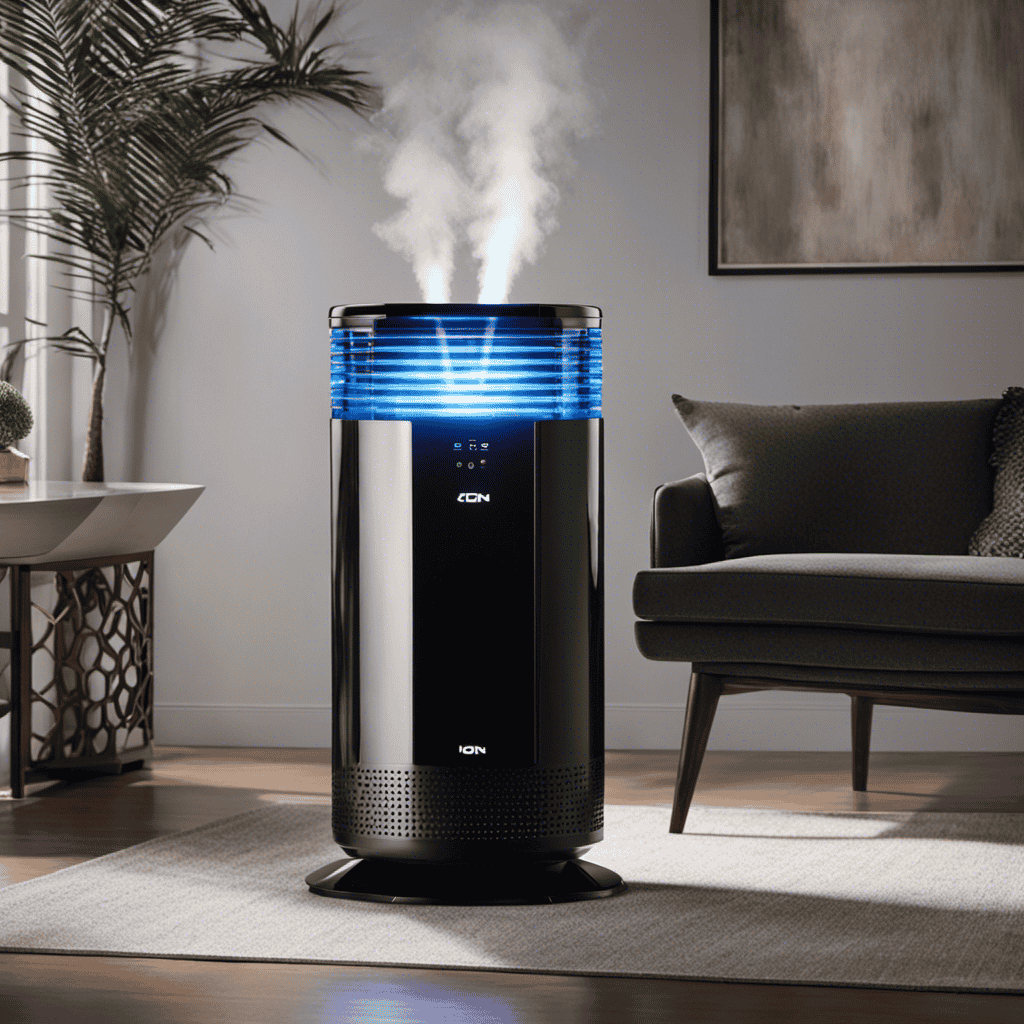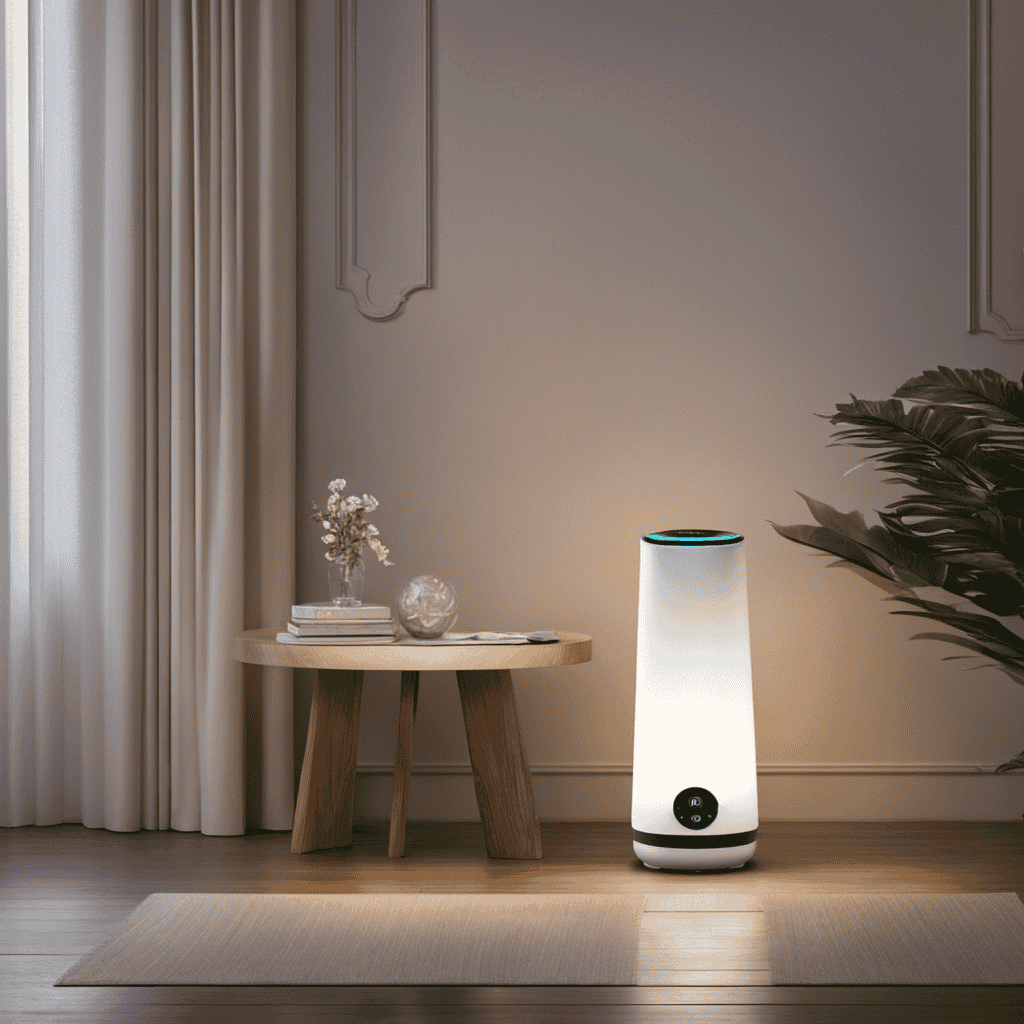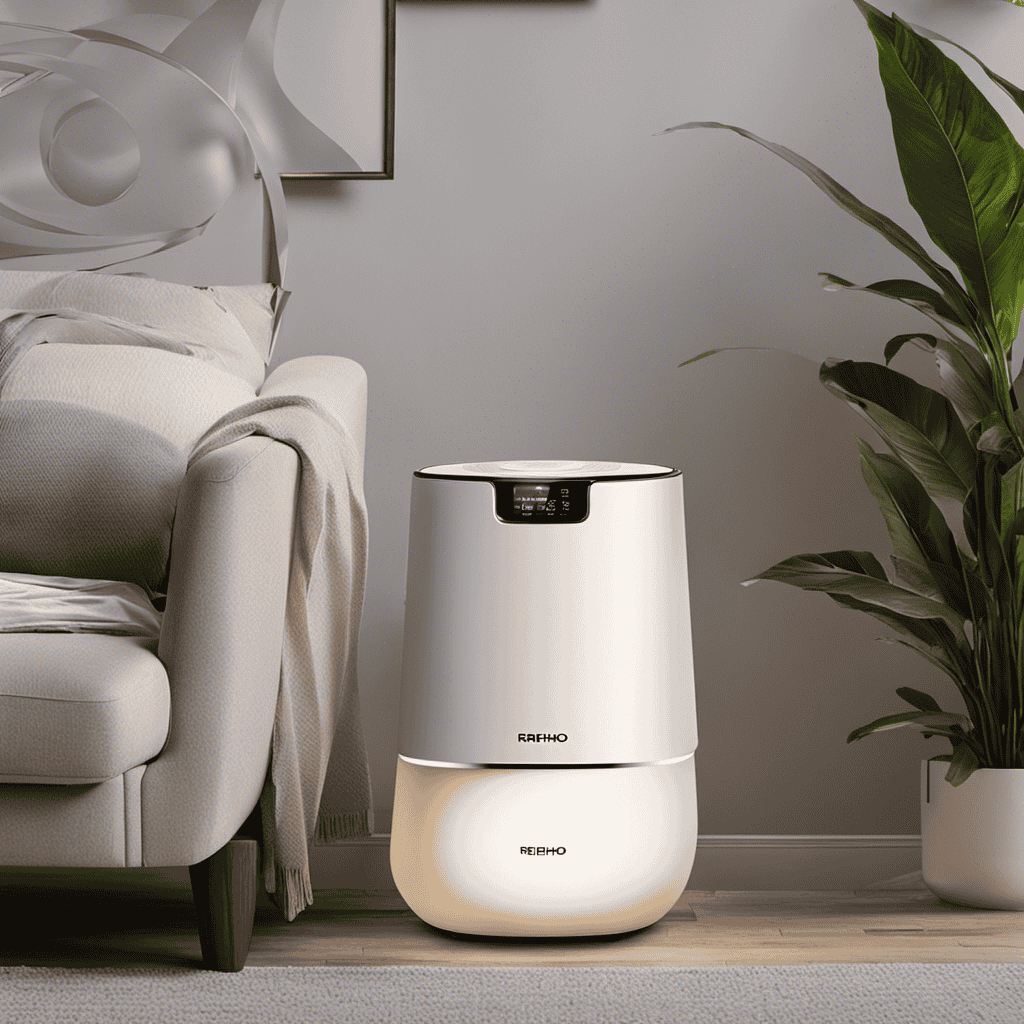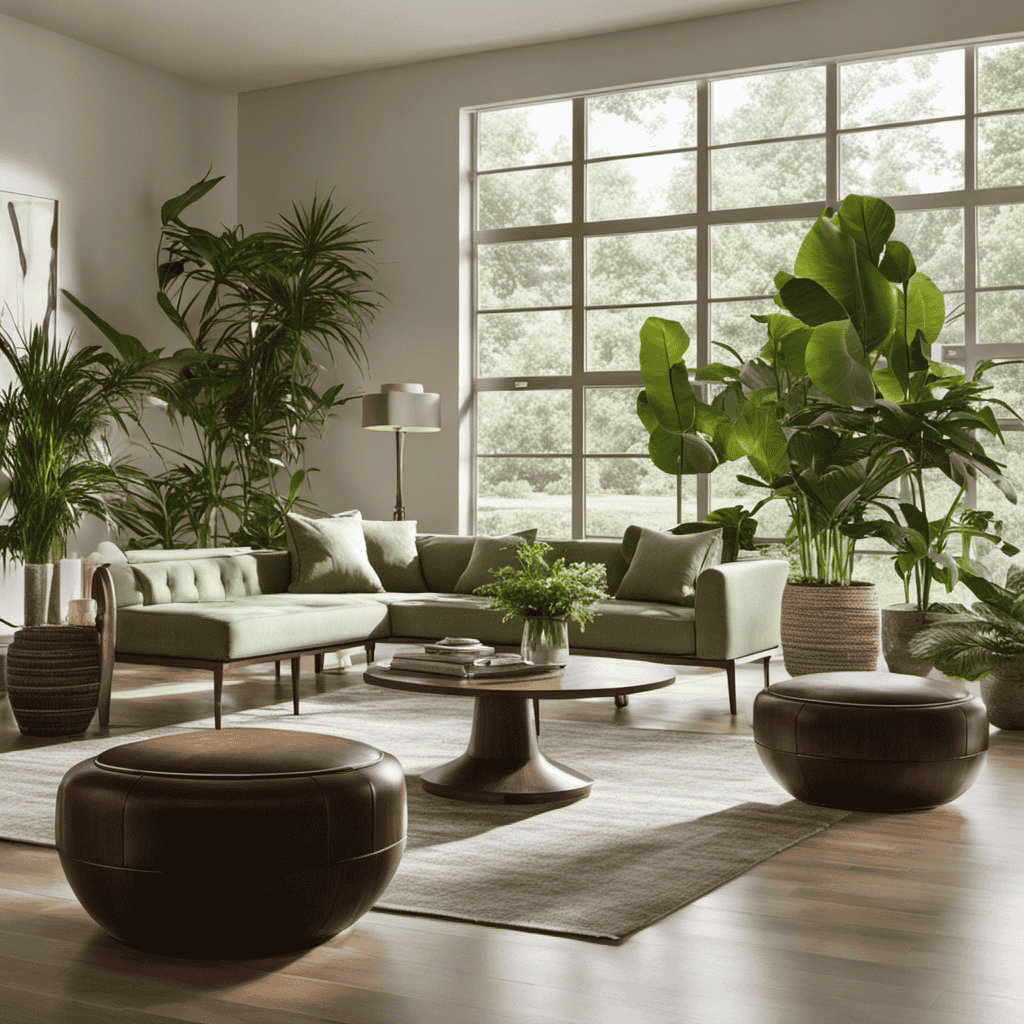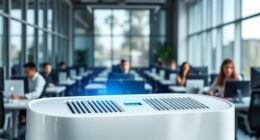I am amazed at how fresh the air in my house feels now that I have started using an ion air purifier. It’s incredible how such a small device can have such a significant impact.
In this article, I will explore the science behind ionization in air purifiers and its impact on indoor air quality. We will dive into the role of ions, the benefits of ionization, and how it helps with airborne pollutants.
Get ready to breathe in fresh, purified air like never before.
Key Takeaways
- Ionization in air purifiers involves the generation of charged particles called ions.
- These ions attract and attach themselves to airborne particles, causing them to become heavier and fall out of the air.
- Ions play a crucial role in enhancing the effectiveness of air purification by neutralizing harmful pollutants, reducing allergens, and eliminating odors.
- While negative ions have a positive impact on well-being and mental clarity, exposure to high levels of positive ions can have negative effects on mental health and respiratory conditions.
How Does Ionization Work in Air Purifiers
So, how exactly does ionization work in air purifiers?
The ionization mechanism in air purifiers involves the generation of ions, which are charged particles, to help remove pollutants from the air. When air passes through the purifier, it encounters an ionization process where electrons are added or removed from the air molecules, creating positively or negatively charged ions.
These ions then attract and attach themselves to airborne particles, such as dust, pollen, or smoke, causing them to become heavier and fall out of the air. This process effectively reduces the number of pollutants present in the air. Understanding the ionization process in air purifiers is crucial in comprehending how these devices improve indoor air quality.
Now, let’s delve into the role of ions in air purification.
The Role of Ions in Air Purification
When it comes to air purification, ions play a crucial role in enhancing the effectiveness of the process.
Ions have several benefits in purification, such as neutralizing harmful pollutants, eliminating odors, and reducing allergens.
Moreover, ions are highly effective in cleaning the air as they attach themselves to airborne particles, causing them to become heavier and eventually settle down, resulting in cleaner and healthier indoor air quality.
Ion Benefits in Purification
Ionized air has been shown to remove harmful pollutants and improve overall air quality. This is achieved through the use of ionization technology, which releases negatively charged ions into the air.
These ions attach themselves to airborne particles, such as dust, pollen, and pet dander, causing them to become heavier and fall to the ground or be trapped by filters. This process effectively reduces the concentration of allergens and irritants in the air, making it beneficial for individuals with asthma.
Ionizers have been found to decrease asthma symptoms by reducing the triggers that can exacerbate the condition, such as indoor air pollutants. The use of ionization technology in air purifiers has therefore been recommended as a potential solution for improving indoor air quality and reducing asthma symptoms.
Ion Effectiveness in Cleaning
To effectively clean the air, you’ll want to consider the effectiveness of ionization technology. Ionization techniques have been proven to be highly effective in removing airborne pollutants and improving indoor air quality.
When an ionizer is used in an air purifier, it releases negatively charged ions into the air. These ions attach to positively charged particles such as dust, pollen, and smoke, causing them to become heavy and fall to the ground or stick to surfaces. This process, known as ionization, effectively removes these pollutants from the air, reducing their presence and improving overall air cleanliness.
Numerous studies have shown the effectiveness of ionization in reducing allergens, smoke, and even certain types of bacteria and viruses. Therefore, when choosing an air purifier, considering the effectiveness of ionization technology is crucial for achieving cleaner and healthier indoor air.
Benefits of Ionization in Air Purifiers
One of the benefits of ionization in air purifiers is that it can help to reduce the presence of airborne allergens. Here are four key advantages of ionization in air purifiers:
-
Improved Air Quality: Ionization helps to remove harmful particles from the air, such as dust, pollen, and pet dander. By releasing negative ions, air purifiers attract these particles and remove them from the environment.
-
Reduced Allergy Symptoms: By eliminating airborne allergens, ionization can help alleviate symptoms of allergies, such as sneezing, itching, and congestion. It provides relief for individuals with asthma or other respiratory conditions.
-
Odor Elimination: Ionization also helps to neutralize odors by binding with odor-causing molecules and eliminating them from the air. This can be particularly beneficial for households with pets, smokers, or cooking odors.
-
Enhanced Mental Clarity: Negative ions produced by ionization can increase serotonin levels, promoting a sense of well-being and improving mental focus.
These benefits make ionization a valuable feature in air purifiers, especially for those suffering from allergies or asthma.
Understanding Negative Ions in Air Purifiers
Understanding the benefits of negative ions in air purifiers can help improve air quality and reduce allergy symptoms.
Negative ions are created through the ionization process, which involves the generation of negative ion generators. These generators release negatively charged particles into the air, which attach to pollutants and allergens, making them heavier and causing them to fall to the ground or be trapped by the air purifier’s filters.
This process effectively removes harmful particles from the air, leading to cleaner and fresher indoor environments. Negative ions have also been shown to have a positive impact on our overall well-being, as they can increase serotonin levels and improve mood and mental clarity.
With the ionization process and negative ion generators, air purifiers have become an essential tool in promoting better air quality and reducing allergy symptoms.
Positive Ions and Air Purification
Positive ions, also known as cations, can have a detrimental impact on air quality and contribute to a range of health problems. Ionization, the process of producing these positive ions, is commonly used in air purifiers. However, it is important to understand the potential effects of ionization on our mental health and sleep quality.
Here are four key points to consider:
-
Mental Health: Studies have shown that exposure to high levels of positive ions can increase symptoms of anxiety, depression, and stress. These ions can disrupt the balance of neurotransmitters in the brain, affecting our mood and overall mental well-being.
-
Sleep Quality: Positive ions in the air can interfere with our sleep patterns. They can disrupt the production of melatonin, a hormone that regulates sleep, leading to difficulty falling asleep and poor sleep quality.
-
Asthma and Allergies: Ionization can worsen symptoms for individuals with asthma and allergies. Positive ions can trigger respiratory distress, increase inflammation in the airways, and worsen allergic reactions.
-
Overall Well-being: In addition to mental health and sleep, high levels of positive ions can also contribute to fatigue, headaches, and a general feeling of discomfort.
It is important to consider the potential negative impacts of ionization on air quality and our health when choosing an air purifier.
Ionizers Vs. HEPA Filters: Which Is Better
When it comes to air purification, two popular options to consider are ionizers and HEPA filters. Both have their own unique technologies and benefits.
Ionizers work by releasing negative ions into the air to attach to and neutralize harmful particles. This process helps to improve indoor air quality by reducing pollutants such as dust, pollen, and mold spores. However, it’s important to note that ionizers may produce small amounts of ozone as a byproduct, which can be a concern for individuals with respiratory issues or sensitivities.
On the other hand, HEPA filters are known for their high efficiency in removing particles from the air. These filters are made up of a dense mesh of fibers that physically trap and remove particles as air passes through them. HEPA filters are capable of capturing a wide range of pollutants, including pet dander, bacteria, and even some viruses.
Understanding the effectiveness of ionizers and the benefits of HEPA filters can help determine which option is better suited for specific air purification needs. It’s important to consider factors such as the size of the space, the types of pollutants present, and any specific health concerns when choosing between these two options.
Effectiveness of Ionizers
You can’t underestimate the effectiveness of ionizers in improving air quality. Ionizers, also known as ion generators, are devices that release negatively charged ions into the air. These ions attach to particles in the air, causing them to become heavier and fall to the ground or be removed by air filters.
When it comes to respiratory diseases like asthma, ionizers can be particularly beneficial. Here’s why:
-
Reduction of airborne allergens: Ionizers can help remove allergens such as dust, pollen, and pet dander from the air, which can trigger asthma symptoms.
-
Elimination of airborne bacteria and viruses: Ionization has been shown to effectively deactivate and remove harmful microorganisms from the air, reducing the risk of respiratory infections.
-
Alleviation of respiratory symptoms: Many individuals with respiratory diseases report improved breathing and reduced symptoms when using ionizers.
-
Enhanced air purification: Ionizers can complement other air purification technologies like HEPA filters, providing a more comprehensive approach to improving indoor air quality.
Overall, ionizers play a significant role in reducing airborne pollutants and improving air quality, making them a valuable tool in managing respiratory diseases like asthma.
Benefits of HEPA Filters?
Now let’s discuss the benefits of HEPA filters in air purifiers.
HEPA stands for High-Efficiency Particulate Air, and these filters are widely recognized for their importance in improving indoor air quality. HEPA filters are designed to capture and trap tiny particles as small as 0.3 microns, including dust, pollen, pet dander, and even some bacteria and viruses. This is achieved through a combination of mechanical filtration and electrostatic attraction.
One of the main advantages of HEPA filters is their ability to remove airborne allergens, which can greatly benefit individuals with allergies or asthma. Additionally, HEPA filters can help reduce the spread of respiratory infections by trapping infectious particles. They also help eliminate unpleasant odors by capturing odor-causing particles.
Furthermore, HEPA filters are highly efficient and can effectively clean the air in a room multiple times per hour. Their effectiveness has been scientifically proven, making them a trusted choice for improving indoor air quality and promoting a healthier living environment.
Ionization Technology in Air Purifiers
Take a moment to consider how ionization technology can improve the air quality in your home with an ion on air purifier.
Here are some key points about ionization technology:
-
Pros of ionization technology:
- Effectively removes airborne particles such as dust, pollen, and pet dander.
- Can eliminate odors and harmful gases in the air.
- Does not require filter replacement, saving money in the long run.
- Can cover a large area, ensuring clean air in multiple rooms.
-
Cons of ionization technology:
- Produces ozone as a byproduct, which can be harmful in high concentrations.
- May not be as effective at filtering out larger particles compared to other technologies.
- Requires regular cleaning to maintain optimal performance.
- Some studies suggest potential negative health effects from prolonged exposure.
When it comes to the environmental impact of ionization, it’s important to note that the production of ozone contributes to air pollution. However, newer ionization technologies are designed to minimize ozone production and adhere to strict regulations.
Are Ionizers Safe to Use
In this discussion, I’ll be examining the health risks associated with using ionizers as well as their effectiveness in improving air quality.
It’s important to evaluate the potential negative impacts of ionizers on our health. Some studies suggest that they may release ozone and other harmful byproducts into the air.
Additionally, we’ll explore the scientific evidence regarding the ability of ionizers to effectively remove pollutants and allergens from indoor environments.
Ionizer Health Risks
Using an ionizer in your air purifier may have potential health risks. It is important to understand the safety concerns associated with ionizers and the potential long-term effects of ionization. Here are four key points to consider:
-
Ozone production: Some ionizers generate ozone, a harmful gas that can irritate the respiratory system and worsen existing respiratory conditions such as asthma.
-
Lung irritation: Ionizers can release charged particles into the air, which may irritate the lungs and cause respiratory symptoms like coughing and wheezing.
-
Fine particle emissions: While ionizers may remove larger particles from the air, they can also produce fine particles that can be inhaled deep into the lungs and potentially cause health issues.
-
Lack of regulation: Unlike other air purifier technologies, ionizers are not regulated by specific safety standards, making it difficult to assess their potential risks.
Considering these factors, it is important to weigh the potential benefits of using an ionizer against the possible health risks associated with their use.
Effectiveness of Ionizers
To assess the effectiveness of ionizers, it’s important to consider their ability to remove pollutants from the air and improve overall air quality.
Ionizers work by releasing negative ions into the air, which attach themselves to positively charged particles such as dust, pollen, and smoke. These particles then become heavier and fall to the ground or are easily captured by the air purifier’s filters.
When comparing ionizers to HEPA filters, it’s worth noting that while both can effectively remove pollutants, ionizers have the advantage of being able to remove smaller particles that may escape the filter.
However, it’s important to remember that ionizers may also produce ozone as a byproduct, which can be harmful in high concentrations.
Therefore, it is crucial to consider the specific needs and requirements of your environment before choosing an air purifier.
The Science Behind Ionization in Air Purifiers
The science behind ionization in air purifiers is fascinating and has been proven to be effective in removing pollutants from the air. Here are four key points to understand about the ionization mechanism in air purifiers:
-
Ionization mechanism: Air purifiers with ionizers work by releasing negatively charged ions into the air. These ions attach themselves to airborne particles, such as dust, pollen, and smoke, making them heavier and causing them to fall to the ground or stick to surfaces.
-
Increased ion concentration levels: By increasing the concentration of ions in the air, ionizers help to neutralize and remove harmful pollutants. This process improves indoor air quality and reduces the risk of respiratory problems caused by airborne irritants.
-
Reduction of airborne particles: The ionization process in air purifiers effectively reduces the number of airborne particles, including allergens and pathogens. This can be especially beneficial for individuals with allergies or respiratory conditions.
-
Combining with filtration: Ionizers are often used in conjunction with other air purification technologies, such as filters, to achieve even better results. The combination of ionization and filtration can provide a comprehensive approach to purifying the air and creating a healthier environment.
Overall, the science behind ionization in air purifiers offers a promising solution for improving indoor air quality by reducing pollutants and enhancing the overall cleanliness of the air we breathe.
Do Ionizers Remove Odors
In the previous subtopic, we explored the science behind ionization in air purifiers. Now, let’s delve into another important aspect of ionizers: their ability to remove odors. Ionizers work by releasing negative ions into the air, which attach to particles and cause them to become heavy and fall to the ground or stick to surfaces. This process can help eliminate certain odors in the air, including those caused by pets. However, it’s important to note that ionizers alone may not completely eliminate all odors. Some odors, such as those caused by bacteria, may require additional filtration methods to be effectively removed. To better understand the effectiveness of ionizers in removing odors, let’s take a look at the following table:
| Odor type | Effectiveness of ionizers |
|---|---|
| Pet odors | Moderate |
| Bacterial odors | Limited |
| Chemical odors | Limited |
| Smoke odors | Limited |
While ionizers can provide some relief from pet odors, they may not be as effective in eliminating bacterial or chemical odors. For these types of odors, it may be necessary to consider additional air purifier technologies or methods.
Ionization and Allergen Removal in Air Purifiers
If you’re looking to reduce allergens in your home, ionization can be an effective method. Here are four ways ionization can help with allergen removal:
-
Ionization technology releases negatively charged ions into the air, which attach to and neutralize allergens such as pollen, dust mites, and mold spores.
-
By reducing the presence of these allergens in the air, ionization can help control symptoms of asthma and other respiratory conditions.
-
Ionization can also be beneficial for pet owners, as it can help reduce pet dander, a common allergen that can trigger allergic reactions in sensitive individuals.
-
Furthermore, ionization can help eliminate odors caused by allergens, improving the overall air quality in your home.
Transitioning into the next section about the effectiveness of ionization in air purifiers, it is important to understand the various technologies and features available to choose the best air purifier for your needs.
The Effectiveness of Ionization in Air Purifiers
When it comes to reducing allergens in your home, ionization can be an effective method to consider. Ionization in air purifiers works by releasing negative ions into the air, which attach to positively charged particles like allergens, dust, and pollutants. These particles then become heavy and fall to the ground or get caught in the air purifier’s filter, effectively removing them from the air.
However, it’s important to note that ionization in air purifiers has some potential side effects. The release of negative ions can generate ozone, a harmful gas that can irritate the lungs and worsen respiratory conditions. It is essential to choose an air purifier that has low ozone emissions or is ozone-free to minimize any potential risks.
When comparing ionization with other air purification methods, such as HEPA filters or activated carbon filters, it’s important to consider the specific needs of your environment. Ionization can be effective in reducing airborne particles but may not be as efficient in removing larger particles or odors. HEPA filters, on the other hand, are highly effective in capturing both small and large particles, while activated carbon filters excel at removing odors and chemicals.
How Ionization Helps With Airborne Pollutants
To effectively reduce airborne pollutants, consider the benefits of ionization in your home. Ionization is a process that uses charged ions to purify the air by attracting and neutralizing harmful particles. Here are four reasons why ionization can help improve your indoor air quality:
-
Removes allergens: Ionizers can effectively remove allergens such as pollen, dust mites, and pet dander from the air, providing relief to those with allergies.
-
Eliminates odors: Ionization can neutralize unpleasant odors caused by cooking, pets, or smoke, leaving your home smelling fresh and clean.
-
Reduces airborne bacteria and viruses: By releasing negatively charged ions, ionizers can help reduce the presence of airborne pathogens, promoting a healthier environment.
-
Improves air circulation: Ionization can help to improve air circulation by causing particles to clump together, making them easier to filter out of the air.
Ionization and Improved Indoor Air Quality
When it comes to ionization and pollutants, it is important to understand how ions can help improve indoor air quality. Ionization works by releasing charged particles into the air, which attach to airborne pollutants and cause them to become larger and heavier, making it easier for air purifiers to capture them.
The benefits of ionization include reducing the presence of pollutants such as dust, allergens, and bacteria in the air, which can lead to improved respiratory health and overall well-being.
However, it is also important to consider the potential health effects of ionizers, as certain individuals may be more sensitive to the increased levels of ions in the air.
Ionization and Pollutants
You can easily remove pollutants from the air using ionization technology in the Ion On air purifier. The ionization process works by releasing negative ions into the air, which attach to harmful particles such as dust, pollen, and pet dander. These ions then become heavy and fall to the ground, effectively removing them from the air you breathe.
Here’s why ionization is an effective way to purify the air:
-
Removes airborne pollutants: Ionizers attract and remove pollutants from the air, improving indoor air quality.
-
Eliminates allergens: The ionization process helps reduce allergens like pollen and dust, providing relief for allergy sufferers.
-
Reduces odors: Ionizers neutralize odors by attaching to the molecules responsible for unpleasant smells.
-
No harmful ozone: Unlike some other air purifiers, Ion On does not produce ozone, ensuring a safe and healthy environment.
Benefits of Ionization
One of the benefits of ionization is that it effectively removes harmful particles from the air. The ionization process involves the release of negatively charged ions into the air. These ions attach themselves to airborne particles, such as dust, pollen, and pet dander. Once attached, the particles become negatively charged and are attracted to positively charged surfaces, such as walls or furniture. This causes them to settle out of the air, effectively removing them from the breathing space.
Additionally, ionization can also help neutralize odors and reduce the presence of bacteria and viruses in the air. These benefits make ionization a valuable tool for improving indoor air quality.
Transitioning to the next section, it is important to consider the potential health effects of ionizers.
Ionizers and Health Effects
Using an ionizer can have potential health effects that should be considered. Ionizers emit negatively charged ions into the air, which can have both positive and negative impacts on our health. Here are four key points to understand about ionizers and their effects on mental health and asthma management:
-
Mental Health: Some research suggests that negative ions produced by ionizers may have a positive effect on our mood and overall mental well-being.
-
Asthma Management: Ionizers claim to improve air quality by removing allergens and pollutants, which can be beneficial for individuals with asthma. However, more studies are needed to determine the effectiveness of ionizers in asthma management.
-
Potential Health Risks: There have been concerns about the production of ozone as a byproduct of ionization, which can be harmful to our respiratory system and exacerbate asthma symptoms.
-
Personal Sensitivities: Individuals with respiratory conditions or sensitivities may react differently to ionizers, and it is important to consider personal health needs when using these devices.
Considering the potential benefits and risks, it is essential to further explore the impact of ionization on respiratory health.
Ionization and Its Impact on Respiratory Health
Ionization can have a positive effect on respiratory health by reducing airborne pollutants. Negative ions, which are produced by ionizers, attach themselves to airborne particles like dust, pollen, and smoke, causing them to become heavy and fall to the ground.
This process, known as air ionization, can help alleviate respiratory diseases such as asthma, allergies, and chronic obstructive pulmonary disease (COPD). Research has shown that negative ions can improve lung function, reduce inflammation in the airways, and enhance the body’s ability to clear mucus.
Additionally, negative ions have been found to have a calming effect on the respiratory system, reducing stress and promoting better breathing. While more studies are needed to fully understand the mechanisms behind these benefits, ionization shows promising potential in improving respiratory health.
Frequently Asked Questions
Can Ionization in Air Purifiers Help With Reducing the Spread of Airborne Viruses and Bacteria?
Yes, ionization in air purifiers can help reduce the spread of airborne viruses and bacteria. It is effective in reducing mold spores and mildew presence, and it improves overall indoor air quality.
How Long Do the Ionization Plates in Air Purifiers Typically Last Before Needing to Be Replaced?
The longevity of ionization plates in air purifiers varies depending on usage and maintenance. For example, in a well-maintained unit, the plates may last up to 1 year before needing replacement. Regular cleaning can extend their lifespan.
Are There Any Potential Side Effects or Health Risks Associated With Using Ionization in Air Purifiers?
There may be potential long term effects and safety concerns associated with using ionization in air purifiers. It is important to thoroughly research and consider these factors before deciding to use this technology.
Can Ionization in Air Purifiers Effectively Remove Pet Dander and Other Pet-Related Allergens From the Air?
Using ionization in air purifiers effectively removes pet dander and other pet-related allergens from the air. It benefits people with respiratory conditions by reducing allergen levels. Ionization is more effective than other technologies for pet allergen removal.
Can Ionization in Air Purifiers Help With Reducing the Presence of Volatile Organic Compounds (Vocs) in Indoor Air?
Ionization in air purifiers can effectively reduce indoor pollutants, including volatile organic compounds (VOCs). When compared to other air purification methods, ionization has shown to be an efficient and scientific solution for improving indoor air quality.
Conclusion
In conclusion, ionization is a highly effective technology used in air purifiers to improve indoor air quality and promote respiratory health. By releasing negative ions into the air, these purifiers can effectively neutralize and remove airborne pollutants such as dust, pollen, and pet dander.
For example, a recent case study conducted in a home with high levels of airborne allergens showed a significant reduction in allergy symptoms after using an ion-based air purifier for just one week. This demonstrates the real-life impact and effectiveness of ionization in improving the air we breathe.
